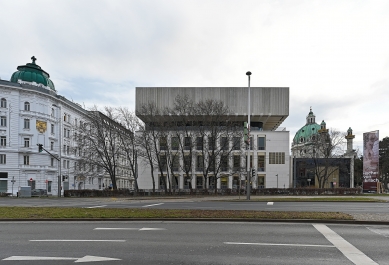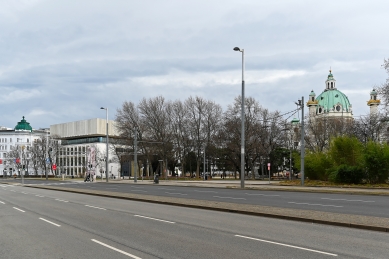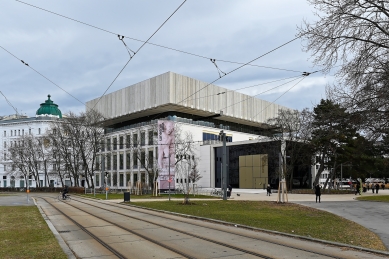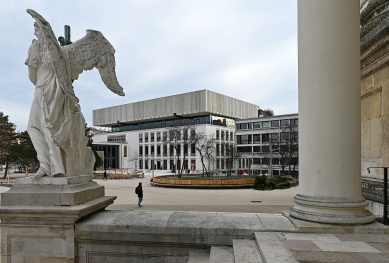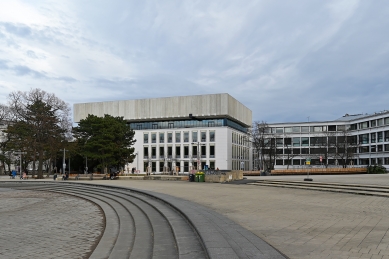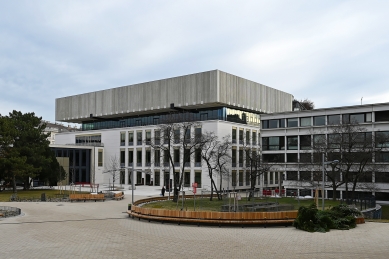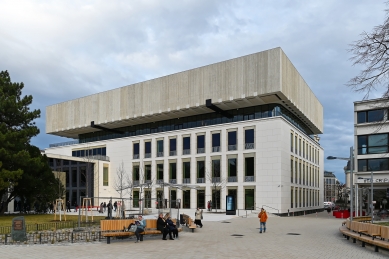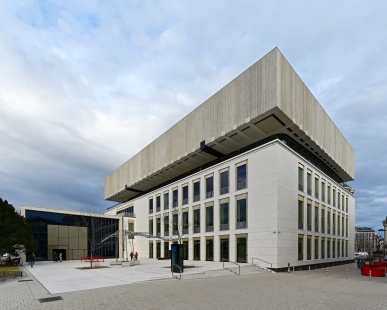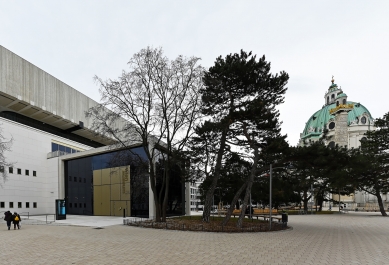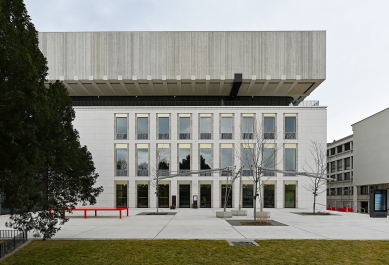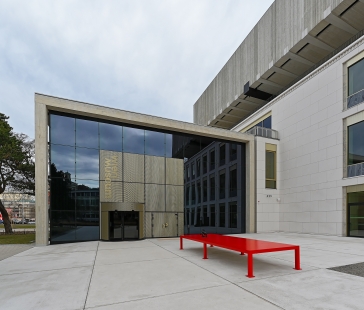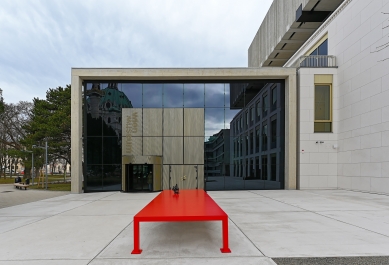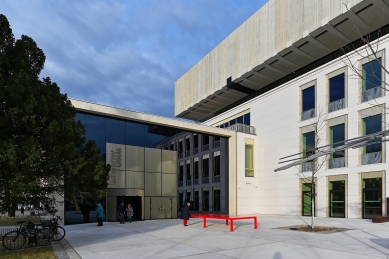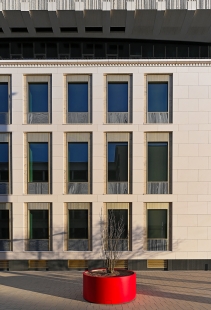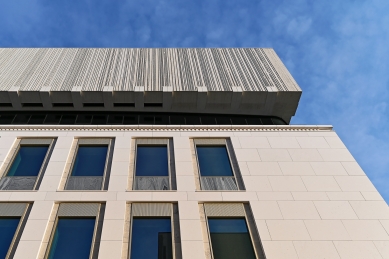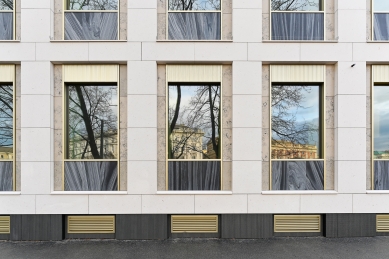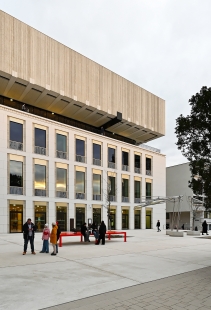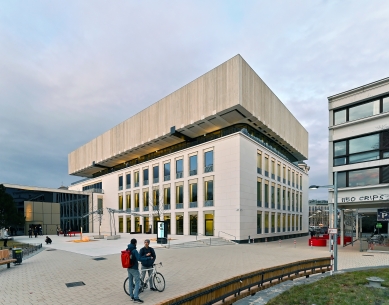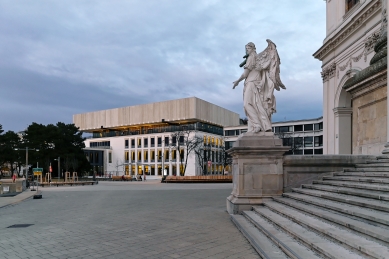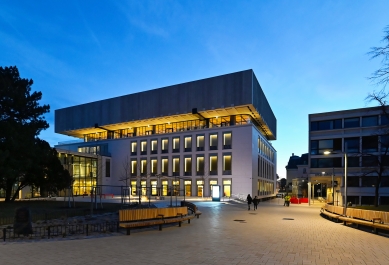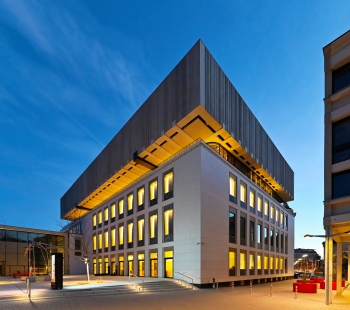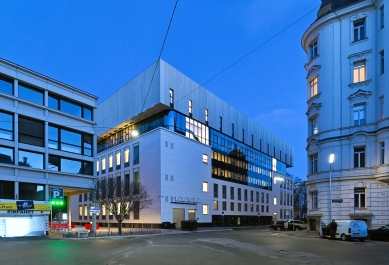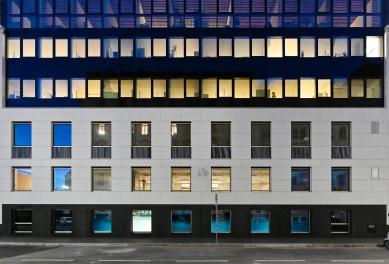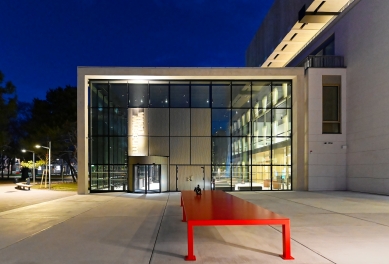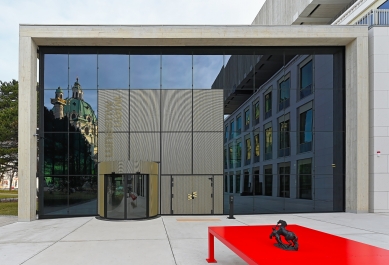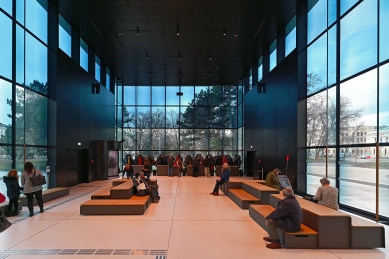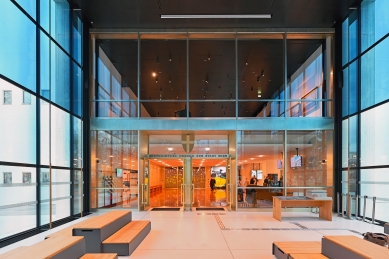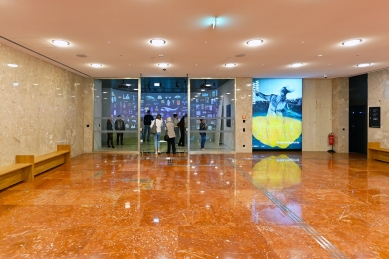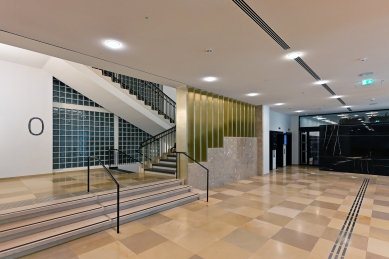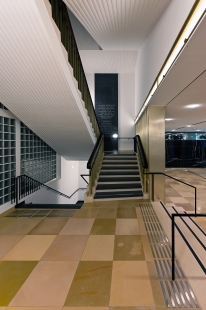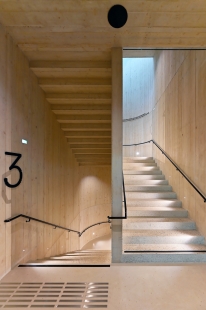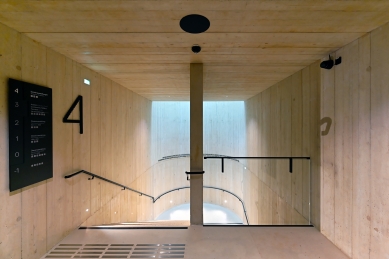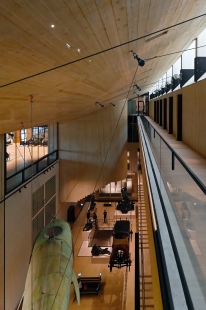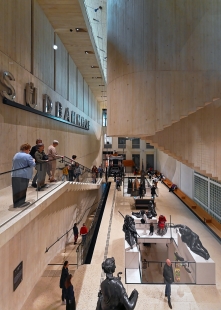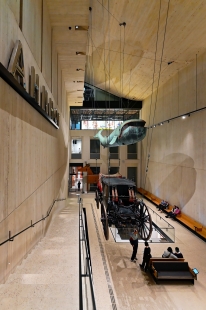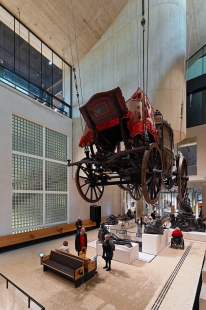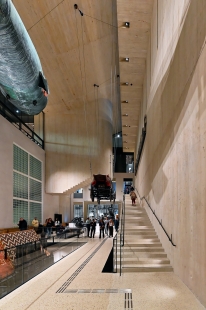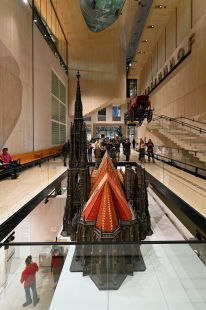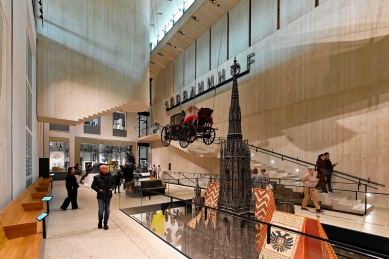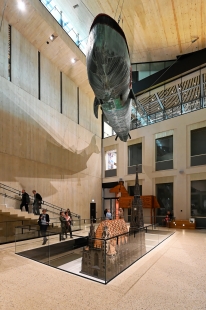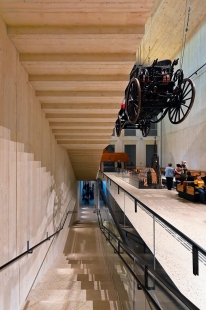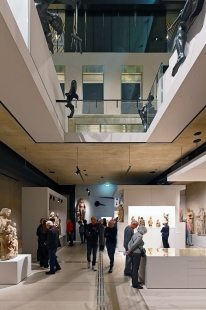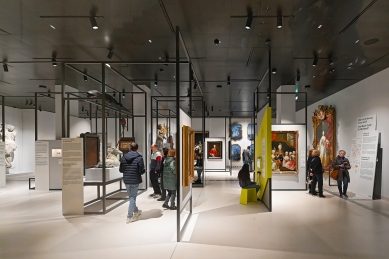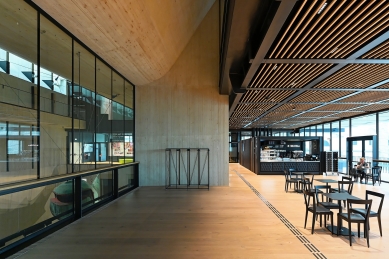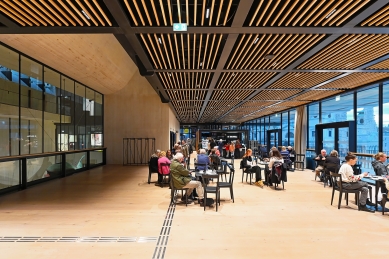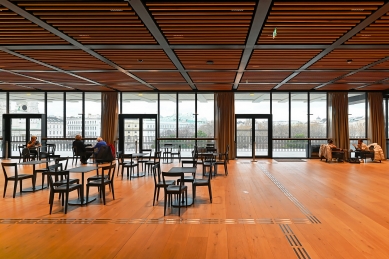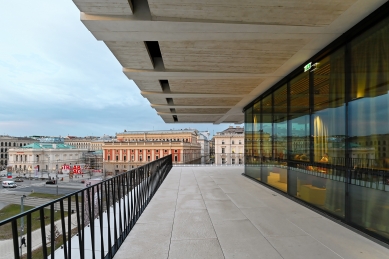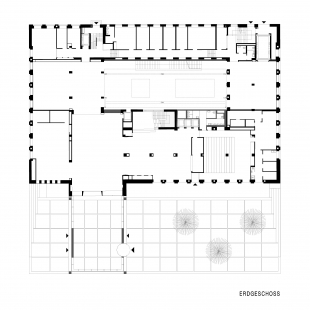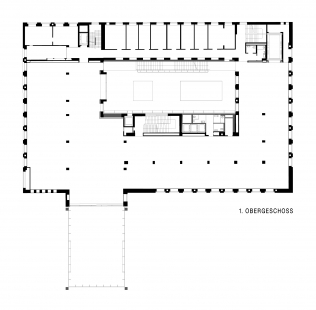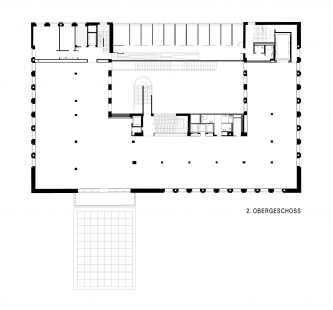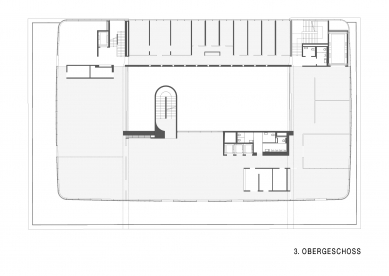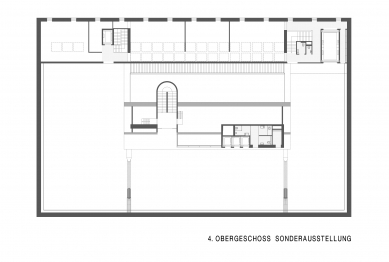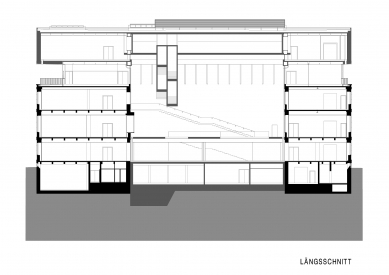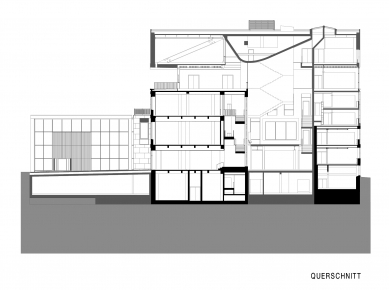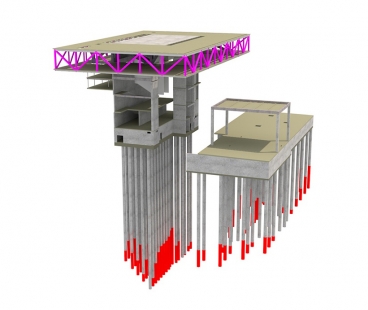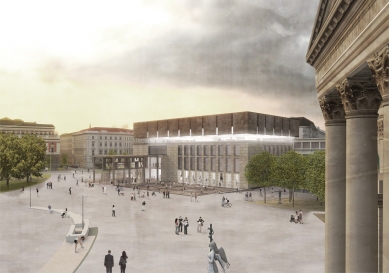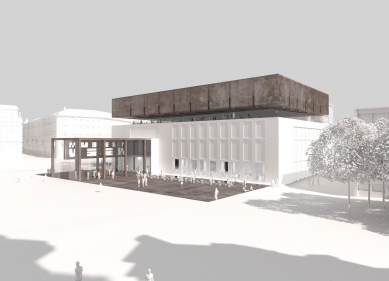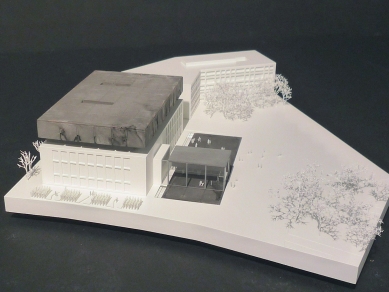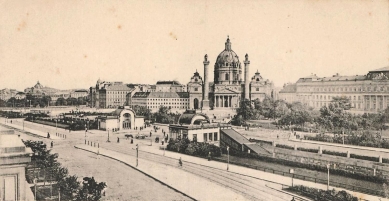
Expansion of the Museum of the City of Vienna
Wien Museum

The Historical Museum of the City of Vienna was founded in 1887 together with the City Museum of Historical Weapons, and initially both collections were located in the neo-Gothic building of the New Town Hall (Friedrich von Schmidt, 1883). The first idea of establishing a separate city museum on Vienna's Karlskirche Square in honor of Emperor Franz Joseph I emerged in the early 20th century when Otto Wagner introduced the so-called "initiatory project," which was in the peak Art Nouveau spirit. The museum was to be built in close proximity to the baroque Church of St. Charles Borromeo (J.B.Fischer von Erlach, 1737). In autumn 1901, a competition was announced, and in spring 1902, a shortlist was held, where the historicizing design of Friedrich Schachner won. A dispute between Schachner's and Wagner's designs was to be resolved by an exhibition organized in spring 1903, when plaster models of both projects were presented to the public. The then Mayor Karl Lueger was more inclined toward Wagner's proposal but feared a negative reaction from the public. In 1907, when Lueger was elected as a member of the Imperial Council, Wagner presented a third reduced variant with geometric ornamentation. Princess Metternich initiated a petition against that project and mobilized conservative members of the aristocracy. In January 1910, a life-size mock-up of part of Wagner's façade was even built at Karlskirche Square, but after Lueger's death, the city council decided in summer 1911 to situate the city museum in the area of the former Schmelz Cemetery (in the place where today stands City Hall, R.Rainer 1958).
With the onset of World War I and the collapse of the Austro-Hungarian monarchy, the idea of establishing a separate building faded for many decades, only to be revived in 1953 by the city council, which decided to build a museum in honor of the 80th birthday of Theodor Körner (1873-1957), the then President of Austria and former Mayor of Vienna. An open competition was organized, inviting 13 architects (e.g. Clemens Holzmeister or Karl Schwanzer). Ultimately, 96 submissions were received from eighty participants. The jury, chaired by Franz Schuster, eventually commissioned Oswald Haerdtl, whose moderate modernist design came in fourth place. The museum on Karlskirche Square was ceremoniously opened on April 23, 1959 (President Körner did not live to see the opening of the museum, and the building's architect died a quarter of a year after the completion of the construction). It was the first museum building completed in Austria after World War II. In 2000, the inner courtyard was covered, and six years later, the entrance area and the storage facility were renovated, but the museum still struggled with insufficient exhibition space (the collections exceed one million exhibits).
At the beginning of the millennium, the construction of a new museum near the main Vienna train station was considered (A.Wimmer, 2015), but in the end, the expert committee decided to keep the museum on Karlskirche Square, and in 2015 an international competition was announced for renovation and expansion. The competition attracted 274 entries from 26 countries (e.g. Zaha Hadid, Norman Foster, Kengo Kuma, or Snøhetta). Fourteen projects advanced to the second round. The jury, chaired by Emanuel Christ, ultimately selected the Austrian studio Čertov, Winkler+Ruck Architekten (the second place went to the Berlin studio Kim Nalleweg Architekten and the third place was taken by Ilg Santer Architekten from Zurich).
The jury chairman Emanuel Christ accompanied the winning project with the following comment: "It is a simple idea that is easy to remember and also practical. It attaches a 'light cap' to the listed Haerdtl building, which is another 'layer of the era'. From the rooftop terrace of the 'Vienna Room', which is designed as a transparent link between the old and new parts, there is a panoramic view of Karlskirche Square and a large part of the city. As a visitor, you can see everything inside that you see from the terrace. The Museum of the City of Vienna literally enters into an open dialogue with the city. It is a beautiful, functional, and meaningful architectural gesture."
The winning team (Roland Winkler and Klaudia Ruck from Carinthia and Ferdinand Čertov from Styria) succeeded with the idea of adding a glass entrance pavilion and a brutalist roof extension to the original stone-clad modernist building, where temporary exhibitions are held (currently, an exhibition commemorating the 300th anniversary of the death of the baroque master J.B.Fischer von Erlach is taking place here until the end of April), while the permanent exhibitions, from the Neolithic beginnings through the period of the Roman military camp to the 20th century, are located in the original building. The opening of the museum was originally planned for 2020, but in the end, the significantly expanded museum reopened after a four-year renovation on December 6, 2023. In the glass gap between Haerdtl's building and the roof extension, there is a restaurant with a panoramic terrace along with educational spaces. Previously, the museum on Karlskirche Square was easily overlooked. After the completion of the roof extension of profiled exposed concrete, it will start to attract attention and many locals will have to get used to the new landmark. However, the authors' main goal was not to provoke controversy but primarily to double the exhibition space capacity (from 6900 m² to 12000 m²) and attract as many visitors as possible (entry to the permanent exhibitions is free, and the restaurant with the rooftop terrace can operate independently of the museum).
With the onset of World War I and the collapse of the Austro-Hungarian monarchy, the idea of establishing a separate building faded for many decades, only to be revived in 1953 by the city council, which decided to build a museum in honor of the 80th birthday of Theodor Körner (1873-1957), the then President of Austria and former Mayor of Vienna. An open competition was organized, inviting 13 architects (e.g. Clemens Holzmeister or Karl Schwanzer). Ultimately, 96 submissions were received from eighty participants. The jury, chaired by Franz Schuster, eventually commissioned Oswald Haerdtl, whose moderate modernist design came in fourth place. The museum on Karlskirche Square was ceremoniously opened on April 23, 1959 (President Körner did not live to see the opening of the museum, and the building's architect died a quarter of a year after the completion of the construction). It was the first museum building completed in Austria after World War II. In 2000, the inner courtyard was covered, and six years later, the entrance area and the storage facility were renovated, but the museum still struggled with insufficient exhibition space (the collections exceed one million exhibits).
At the beginning of the millennium, the construction of a new museum near the main Vienna train station was considered (A.Wimmer, 2015), but in the end, the expert committee decided to keep the museum on Karlskirche Square, and in 2015 an international competition was announced for renovation and expansion. The competition attracted 274 entries from 26 countries (e.g. Zaha Hadid, Norman Foster, Kengo Kuma, or Snøhetta). Fourteen projects advanced to the second round. The jury, chaired by Emanuel Christ, ultimately selected the Austrian studio Čertov, Winkler+Ruck Architekten (the second place went to the Berlin studio Kim Nalleweg Architekten and the third place was taken by Ilg Santer Architekten from Zurich).
The jury chairman Emanuel Christ accompanied the winning project with the following comment: "It is a simple idea that is easy to remember and also practical. It attaches a 'light cap' to the listed Haerdtl building, which is another 'layer of the era'. From the rooftop terrace of the 'Vienna Room', which is designed as a transparent link between the old and new parts, there is a panoramic view of Karlskirche Square and a large part of the city. As a visitor, you can see everything inside that you see from the terrace. The Museum of the City of Vienna literally enters into an open dialogue with the city. It is a beautiful, functional, and meaningful architectural gesture."
The winning team (Roland Winkler and Klaudia Ruck from Carinthia and Ferdinand Čertov from Styria) succeeded with the idea of adding a glass entrance pavilion and a brutalist roof extension to the original stone-clad modernist building, where temporary exhibitions are held (currently, an exhibition commemorating the 300th anniversary of the death of the baroque master J.B.Fischer von Erlach is taking place here until the end of April), while the permanent exhibitions, from the Neolithic beginnings through the period of the Roman military camp to the 20th century, are located in the original building. The opening of the museum was originally planned for 2020, but in the end, the significantly expanded museum reopened after a four-year renovation on December 6, 2023. In the glass gap between Haerdtl's building and the roof extension, there is a restaurant with a panoramic terrace along with educational spaces. Previously, the museum on Karlskirche Square was easily overlooked. After the completion of the roof extension of profiled exposed concrete, it will start to attract attention and many locals will have to get used to the new landmark. However, the authors' main goal was not to provoke controversy but primarily to double the exhibition space capacity (from 6900 m² to 12000 m²) and attract as many visitors as possible (entry to the permanent exhibitions is free, and the restaurant with the rooftop terrace can operate independently of the museum).
The English translation is powered by AI tool. Switch to Czech to view the original text source.
1 comment
add comment
Subject
Author
Date
Tý brďo!...
š
11.03.24 10:58
show all comments


